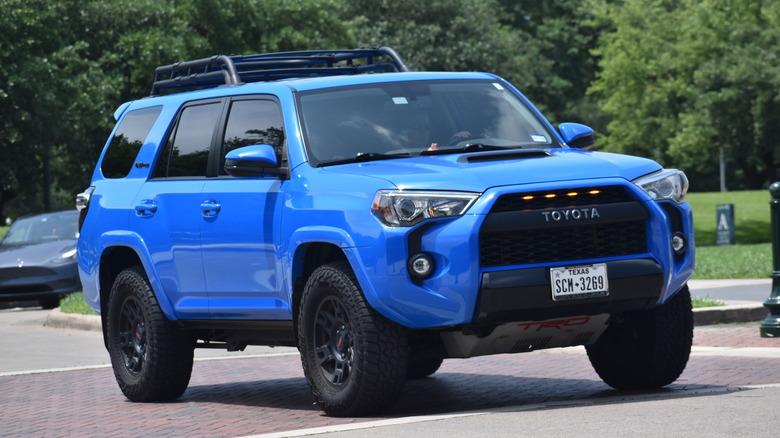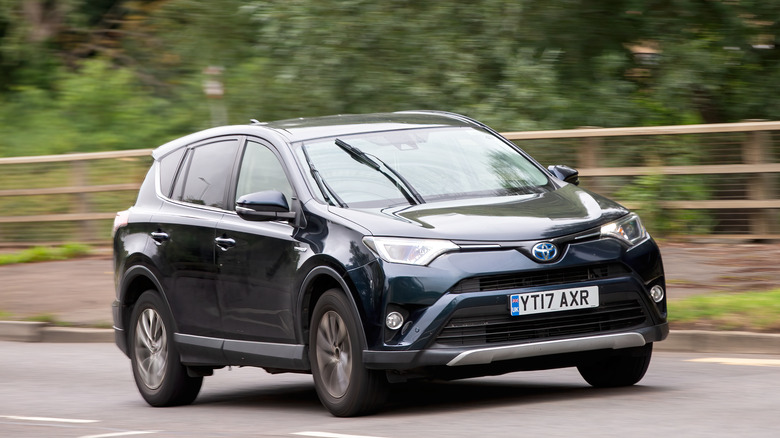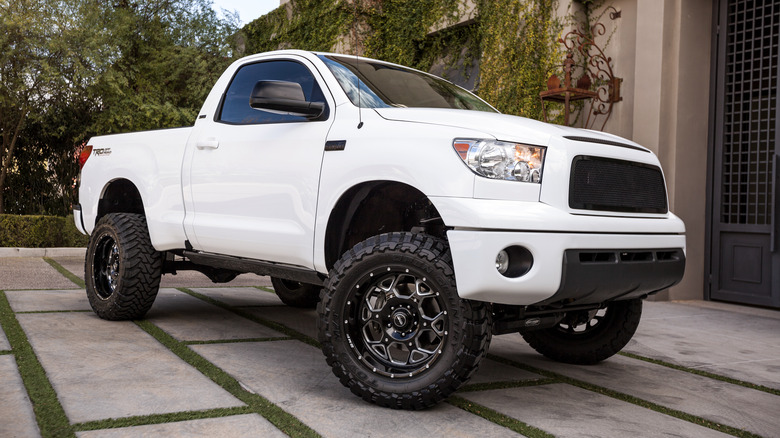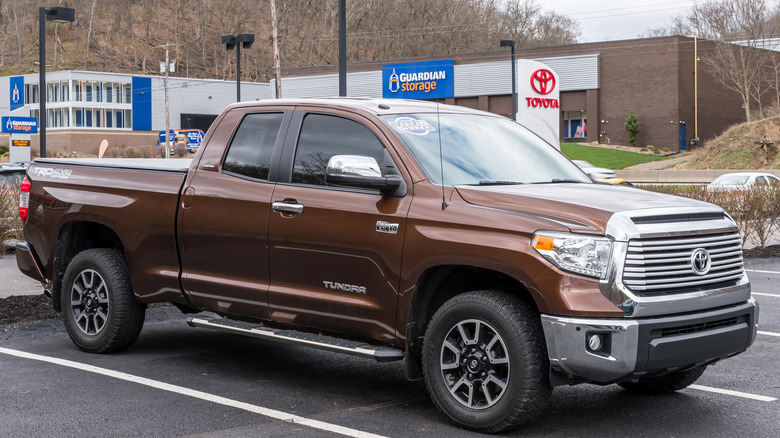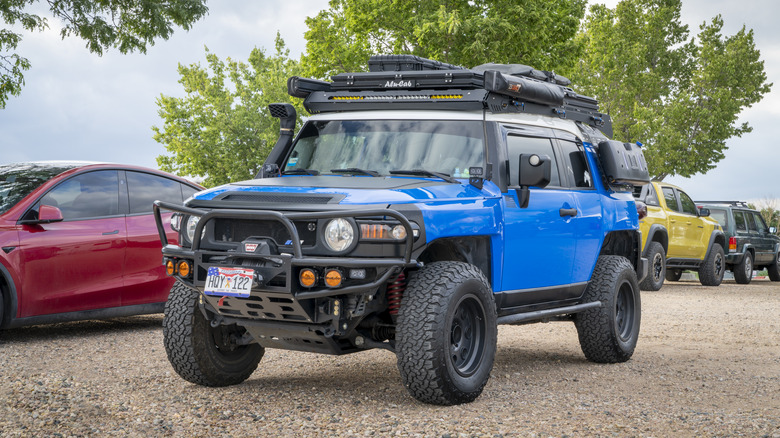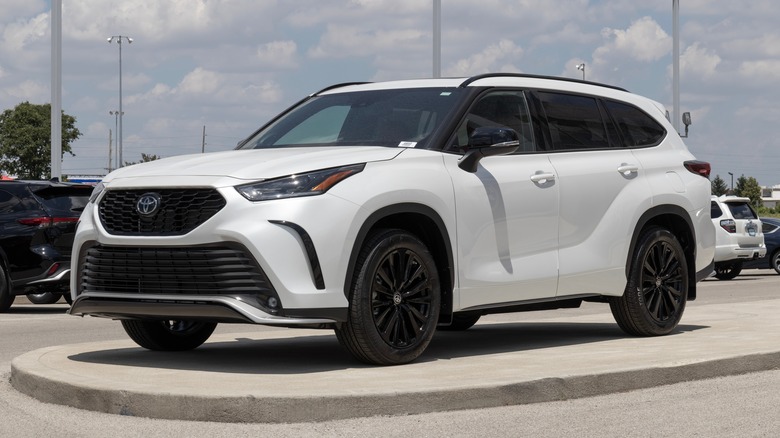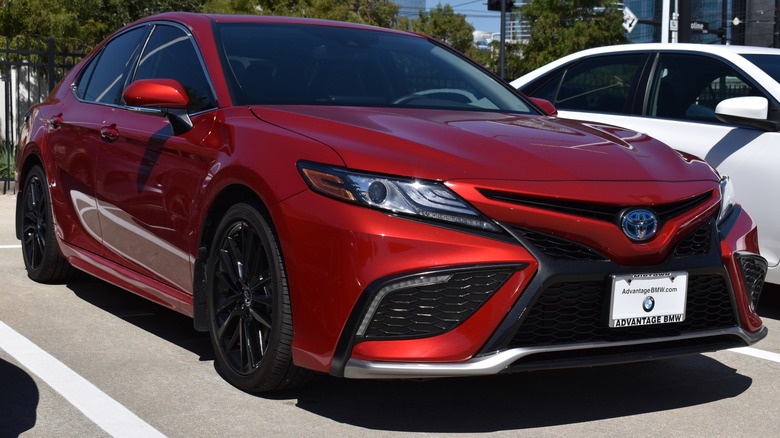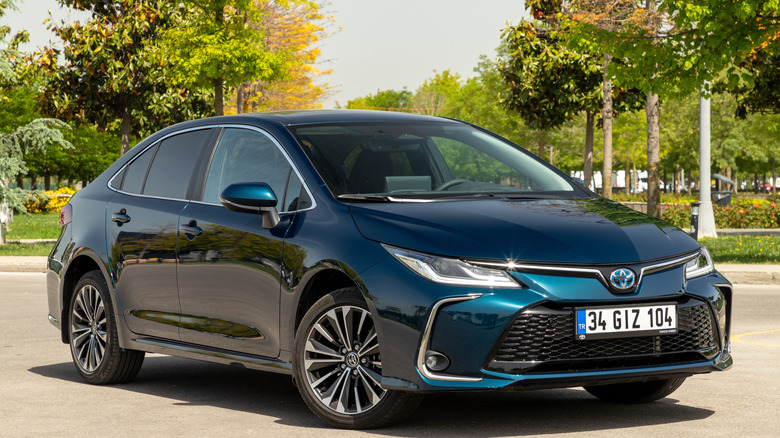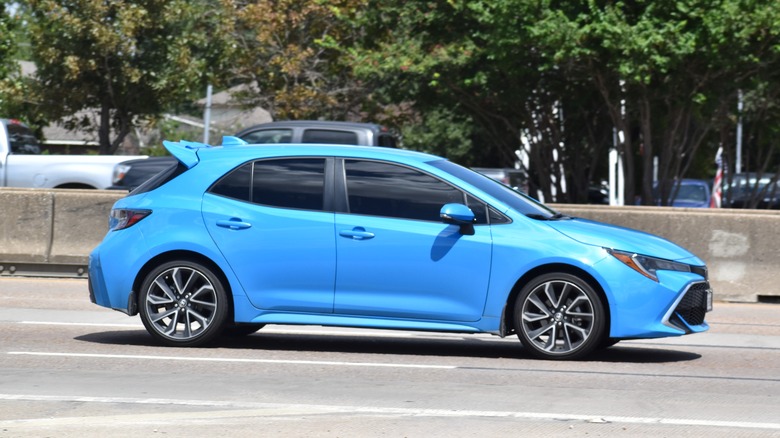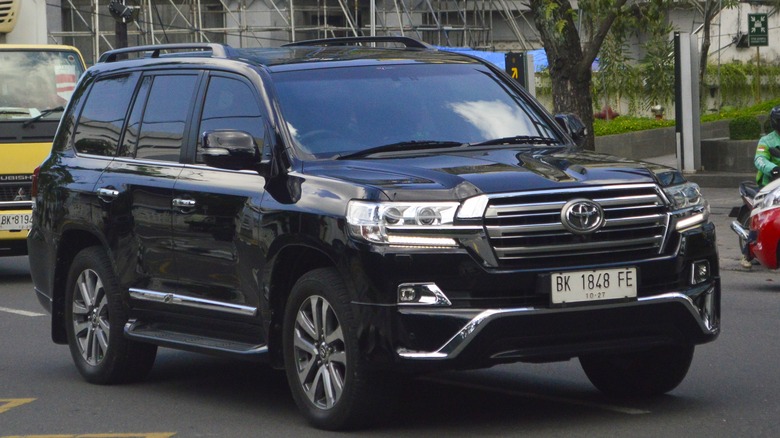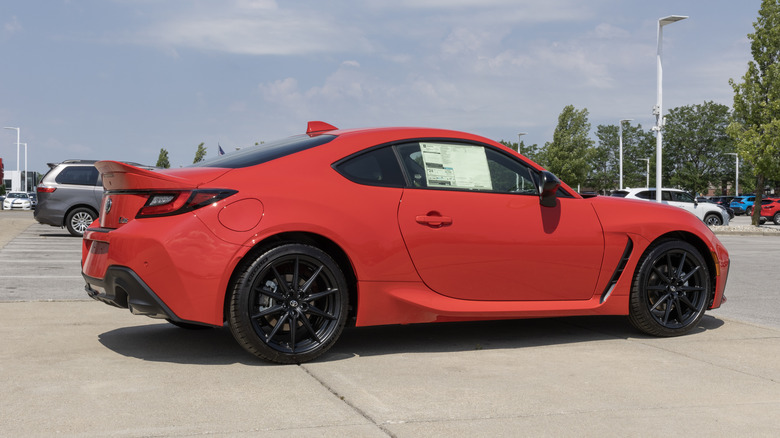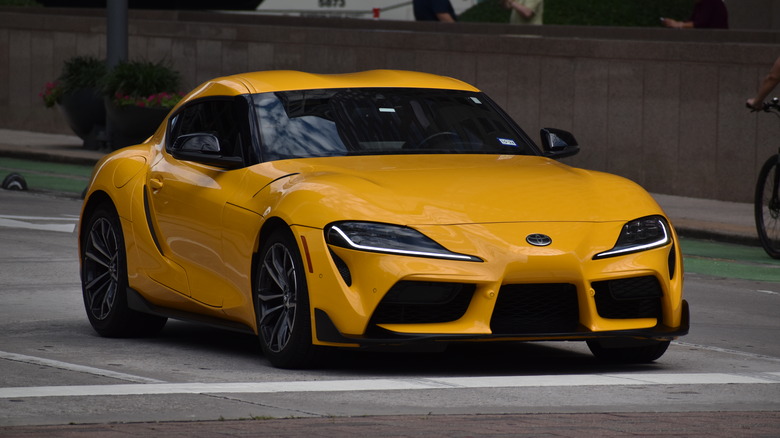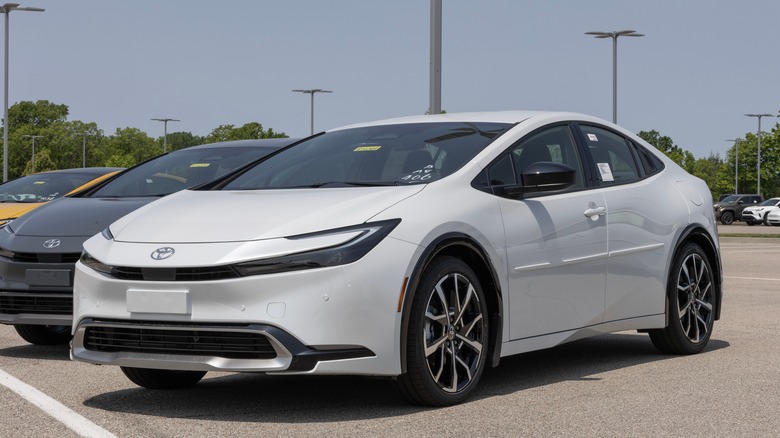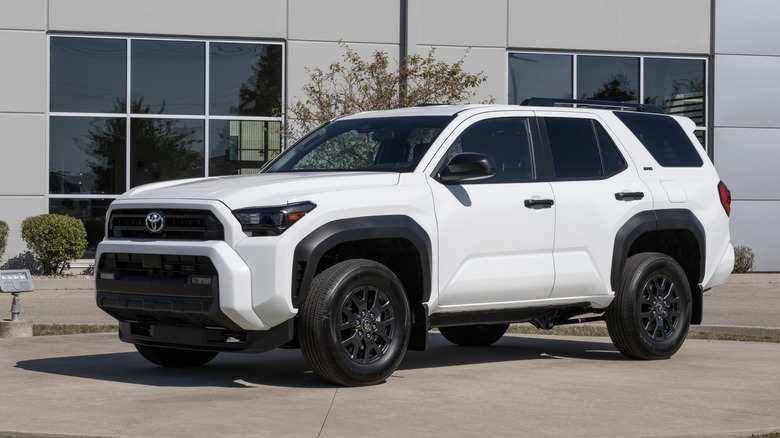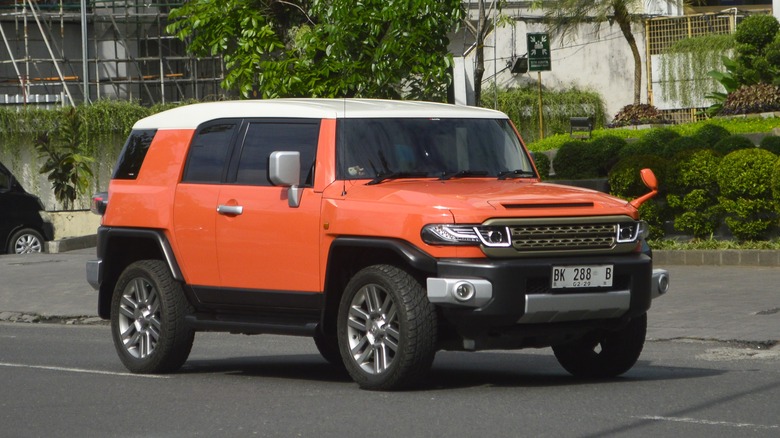13 Of The Best Used Toyota Models
There is one pressing problem when it comes to any sort of "best car" list, and it's that these lists are written by people who have lost track of what the word "best" is supposed to mean. It can mean different things to different people. For instance, the out-of-state college student living in a dorm needs something completely different from a working mum who needs to cart three kids to school and back every day. Some buyers would define best as being the most powerful Toyota SUVs available to them, others would simply want the cheapest Toyota car that they can buy, and still others would want to avoid Toyota models with terrible resale value in order to protect their purchase.
That was our guiding principle when compiling this list, rather than sorting by horsepower or cupholder count. And the fantastic bit of news is that Toyota has managed to make a vehicle that slots nicely into every single bucket, so to speak. Whether a buyer's budget is $6,000 or $36,000, whether the need is basic A-to-B transport, whether buyers need brilliant fuel economy, or cargo capacity, there's a used Toyota to fit the bill. All value recommendations were made using the extensive experience of SlashGear writers having tested these closely related vehicles over the past several decades. So, with all that in mind, here are 13 of the best Toyota models on the used market.
2014 to 2018 RAV4
Many people wrongly quote that the Ford F-150 is the best-selling vehicle in America. In recent years, the most popular vehicle by sales volume has been the Toyota RAV4, which dethroned the F-150 back in 2024. There's a good reason for its popularity, as the RAV4 is a brilliant car, especially if buyers can source the right trim and options list. Specifically, the models from 2014 to 2018 are coming onto the market now, and are a fantastic deal now that depreciation has done its thing. Medium-mileage units in decent condition and with an acceptable spec are going for $7,000 at the moment.
This generation comes with a 2.5 liter four-cylinder engine that makes 176 horsepower and 172 lb-ft of torque paired to a six-speed transmission. Seats five comfortably and has 38.4 cubic feet of boot space, with most trims coming with a power liftgate. The infotainment system is obsolete, but a $200 aftermarket head unit won't fix that. The last thing to note is that the RAV4 was facelifted for 2016 models, and though it was a minor change, it did enhance the car's looks quite a bit. A fun fact to bring up at the next family dinner is that the name, RAV4, is actually a short-form contraction. It stands for "Recreational Active Vehicle with four-wheel drive", a nod to the fact that the original RAV4s were intended to be taken off-road.
2013+ Tacoma
Next up, we have the workhorse of the list, in the form of the Toyota Tacoma. It's not particularly handsome, nor is it comfortable or luxuriously decked out in any stretch of the imagination. The fuel economy is passable on this (or any) generation, coming in at 19 MPG combined, according to estimates by the EPA. The Tacoma also doesn't tow (3,500 pounds) as much as American trucks, and has smaller payloads (1,335 pounds) than most of the offerings on the market.
However, despite all that, the Tacoma remains a fantastic choice for people who need a rugged, uber-reliable truck for the long term. The flagship engine displaces 4.0 liters and is a six-cylinder unit, making 236 horsepower and 266 lb-ft of torque.
J.D. Power gives the 2013 Tacoma a reliability score of 86 out of a total of 100, and its weaknesses are actually its strengths. The smaller size means it's much more maneuverable, and the lower payload means less stress on the frame over the long term. All in all, the Tacoma is a great beast of burden that will last a buyer for decades if properly taken care of.
2015+ Tundra
The 2015 and above Toyota Tundra is a fantastic pickup truck that is a bit more urban-friendly than the Tacoma, and was given a complete redesign for this generation, meaning it's a bit easier on the eyes. Power comes from a 5.7-liter V8 unit that makes 381 horsepower and 401 lb-ft of torque, mated to a six-speed transmission.
Cab choices for this generation include a regular single cab, a crew cab, and a double cab. Trim levels start from the SR, which is the base trim, all the way up to the all-options ticked Platinum trim, though since used prices for these trims are similar, try to snag a limited or SR5 trim if possible. The Tundra comes in with a J.D. Power reliability score of 81 out of a total available 100 points, and boasts a fairly decent EPA-estimated economy of 16 MPG combined.
2008+ FJ Cruiser
It is downright criminal that so many people who write about the "best Toyotas" omit the FJ Cruiser from their lists. It debuted in 2007, and is so legendarily reliable that even models from 2009 with over 200,000 miles are still running like the day they were delivered, provided maintenance was on time. Having been recently retired from the lineup, meaning that you cannot buy a new FJ cruiser now, the demand for these beastly cars has remained sky-high, which is why even 10-year-old FJs are still selling for $40,000.
At that price, buyers can (and definitely should) consider looking at something like a Land Cruiser, which we'll cover further down in this piece. However, for those simply looking for an offroad weekend runabout, models from 2008 and thereabouts are currently going for about $8,000 on the used market.
That generation came with the six-cylinder 4.0-liter engine making 239 horsepower paired to either a five-speed automatic or six-speed manual gearbox. With a couple of aftermarket accessories like rock sliders, a rooftop tent, and a snorkel, this thing will be unstoppable. There's even an inclinometer and a compass included by default in the center of the dash, ready for outdoor adventures from day one.
2020+ Highlander
The Toyota Highlander is a mid-size SUV that is spacious enough to carry the whole family around, while maintaining a comfortable ride. For those who want a bit more than just comfort, the Grand Highlander adds many small luxury touches. The Highlander is powered by a 3.5-liter six-cylinder engine that manages to push out a respectable 295 horsepower and 263 lb-ft of torque. The one drawback (for some people) is that the Highlander's engine is mated to a CVT, or continuously variable transmission, which could raise some questions about long-term durability.
The Highlander is just one of many Toyota models that have a CVT transmission, with the brand having added several models to that list in recent years. The Highlander can seat up to eight passengers (seven if there are captain's chairs in the second row) comfortably across three rows of seating, and has an economy of 24 mpg combined as per the EPA. Cargo space is fairly limited at just 16 cubic feet with the third row up. At the time of writing, a 2020 Highlander with moderate miles and decent options can be had for about $17,000.
Any Generation Toyota Camry
The Toyota Camry is a staple car with a model for every budget and situation. From the instant-noodle college student to the middle-management executive looking for a hybrid car for a tax credit, there will be a Camry suited to every buyer. The budget range is also quite wide, with models from 2010 to 2015 going for about $6,000.
After a major facelift in 2015 that added a lot of visual appeal to the car, the price for used units jumped to about $7,500. Also, contrary to public belief, there are no PHEV versions of the Camry, though most modern units will have some form of mild hybrid assistance system. The 2016 to 2019 generation of Camry that will probably be what most people are looking at right now comes with an optional 3.5-liter V6 engine that makes 302 horsepower; though the standard engine is a four-cylinder unit that makes 208 horsepower.
This powerplant is mated to an eight-speed transmission and gets a very respectable 26 mpg (V6 engine) combined as per EPA estimates. It's also fairly comfortable, low-slung, and spacious in the back; and it comes with the expected Toyota reliability, so it's a safe purchase for most buyers.
2015+ Corolla
Like the Toyota Camry from before, but slightly more affordable. Post-2015 units got a notable facelift that keeps the car looking modern-ish and not like a "beater" vehicle for want of a better word. The engine on this generation was a 1.8-liter four-cylinder that churned out the mighty total of 132 horsepower and not a lot of torque while being paired to a continuously variable transmission. A six-speed manual transmission was an option only on the SE trim of this generation. It is pretty much the default choice of first car for a new driver, just like the Yaris is across the pond in the UK.
Another thing to note is that though the Camry outsells the Corolla in the U.S., the Corolla still sells in huge numbers. This means that affordable spares and experienced labor will be easy to source for both cars. In addition, given the supply glut, finding parts for the Corolla will probably be a lot easier and pocket-friendly when compared to the more upmarket Camry. Price wise, models of a decent trim and from 2015 or thereabouts currently have a going rate of about $5,000, though this varies widely.
GR Corolla
The GR Corolla is an extremely fun to drive hatchback, and is an absolutely different animal when compared to the regular Corolla that we just talked about above. For one, it is a sports-oriented car, which might sound absurd to some people – it's not often that one hears the words "sports car" and "Corolla" in the same sentence. For one, this model is tuned by the folks over at GR, which stands for Gazoo Racing. They are the mad scientists behind cars like GR86 and the GR Supra, both of which we will be covering further down.
The GR Corolla, which is so far the only generation, comes with a 1.6-liter turbo-three cylinder engine that makes 300 horsepower and 273 lb-ft of torque, mated to a manual six-speed gearbox. The prices on these haven't really come down since it's a new model, hovering around the $30,000 mark, but it's a brilliant runabout that is not very common.
2009+ Land Cruiser
No list of the best Toyota vehicles or anything in a similar vein is complete without mentioning the Land Cruiser, a vehicle that is now almost 80 years old. It is best suited for those looking for the ultimate bulletproof vehicle that will last generations without ever leaving buyers stranded. The oldest we'd recommend going if purchasing a Land Cruiser would be 2009, as this was the first of three major facelifts for the vehicle. The next one came about in 2016, and really delivered in the looks department.
The most recent facelift came about with the launch of the new LC300 generation in 2024, and is by far the most modern-looking car Toyota currently makes. However, the sweet spot probably lies in getting a late-generation LC200 model, as the kinks in the LC300 haven't quite been worked out yet. In any case, the LC300 is not sold in the U.S., with only the 250-series, otherwise known as the Prado, being available here with its miserably underpowered engine. All that makes for the LC200 being the best way forward for potential buyers.
The default engine in the late-gen (2015 to 2023) Land Cruisers was a 5.7-liter eight-cylinder that pushed the power figures up to 381 horsepower and 401 lb-ft of torque. All that performance does come at a premium though, with models from 2014 still going for like $30k, but it'll run till the wheels fall off. Probably even after that.
Any Generation GR86
Another offering from the skunkworks-esque Gazoo Racing division is the Toyota GR86, which is very similar to the Subaru BRZ, at least from a visual standpoint. The engine on this pocket rocket is a flat-four that displaces 2.4 liters, and makes 228 horsepower with 184 lb-ft of torque, delivered to the rear wheels via a six-speed transmission. It is a two-door sports coupe, and was Toyota's attempt at getting some market share in the more-affordable sports car segment. They already had their mark V GR Supra that shared underpinnings with the BMW Z-series of the same generation, but with an entry price of almost $60,000, Supras weren't exactly flying off the shelves.
The GR86 was meant to remedy that, but shared the same fate as the Supra which is both a good and a bad thing. It's bad because the customer response to the GR86 very likely means that Toyota will not be trying another two-door sports car anytime soon. The good news however is that these units are available to purchase at now-sane prices on the aftermarket. A 2022 GR86 with moderate miles on the clock can be had for as low as $18,000, which is a steal from any angle.
Mark V Supra
The Supra, currently in its fifth generation, is the halo offering from Toyota's Gazoo Racing division. It delivers Toyota's reliability with a level of performance that is expected only from six-figure supercars from the likes of McLaren and Ferrari. It does zero to 60 mph in 3.9 seconds, has a top speed of 161 mph, and does the quarter mile in 12.4 seconds, at the end of which the speedometer will show 114 mph.
Models are currently available starting from around $36,000 which is a bargain when you consider you're getting a 3.0-liter inline 6 with antilag turbocharging. Some models do have an underpowered 2.0L engine, but the price delta is negligible, so opt for the 3.0 if considering a Supra for your next car. Given that these units used to cost $50,000 back when new in 2021, the price of about $36,000 is not a bad deal at all.
2010+ Prius
While it may be a controversial choice, the Prius definitely deserves a spot on this list. It's cheap to buy, fairly reasonable to maintain, and has a definite fuel economy advantage over every single other model on our list. If all someone cares about is getting the best economy possible without spending an arm and a leg, the Prius' 50-51 mpg is hard to beat. Even models from 2013 (selling for $6,000 or thereabouts) average 45 to 48 mpg. This makes the Toyota Prius an exceptionally good choice for people with a long daily commute. Imagine commuting 40 miles one way, and only having to buy 50 gallons of fuel per month.
Since the Prius holds 12 gallons, you only have to fill up once a week, with regards to that specific example. Prius models from 2015 come with a 1.8-liter inline-4, that made 98 horsepower and 105 lb-ft of torque, in addition to an e-motor that added a further 80 horsepower and 153 lb-ft of torque. Then again, readers are urged to remember that no one buys a Prius for its horsepower and torque figures, but rather for the stellar economy it offers.
2015+ 4Runner
The Toyota 4Runner is essentially targeted at the consumer who wants to cart the entire family around but also wants to go offroad on a regular basis. It's like the Toyota Highlander, but with much more ruggedness and much better style. Where the Highlander would win on creature comforts and cabin luxuries, the 4Runner wins on reliability, durability, and longevity. Also, that's not to say that the 4Runner isn't luxurious, depending on the trim and options that were checked off, the 4Runners can be among the nicest-spec'd vehicles on the market.
The models after 2015 are currently selling on the used market from $18,000 and up for models with a decent options list and trim. That generation comes with a 4.0-liter V6 engine that produces a respectable 270 horsepower and 278 lb-ft of torque. This powerplant is mated to a five-speed automatic transmission, though we don't know how long that'll remain true before Toyota switches even this to a CVT.
We specifically mention trying to nab 2015 or later models because in 2015 the 4Runner got a massive facelift, which added a lot of visual appeal to the car. Prices for older models don't come with much savings, being only about $2,000 less than the 2015 models, so it made more sense to recommend that one.
Methodology
When we set out to compile this list, we first divided our consumers into broad budget categories that they would fall into. We had the economy buyers, who'd want something under $10,000, midrange buyers, who'd look to buy in the $10,000 to $20,000 range, and then the budget-no-issue buyers.
After that, we categorized each buyer's priorities: reliability, performance, passenger capacity, and fuel economy. This gave us three buyer budgets and four buyer priorities, so we tried to have one vehicle in each budget for each priority.
Then we threw in the FJ Cruiser for the adventure crowd. All market prices were accurate at the time of writing in 2025, but may have changed if this article is being read much in the future. Over the past several decades, many SlashGear writers have tested and tried almost every vehicle on this list, so the recommendations made above come from a thorough understanding of these cars and trucks.
